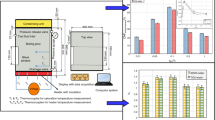Abstract
The pool boiling critical heat flux (CHF) performance of aqueous nanofluids was investigated using various nanoparticles of TiO2, Al2O3, and SiO2. The usage of a nanofluid as a working fluid can significantly enhance the pool boiling CHF, which was found to be strongly dependent on the kind of nanoparticle, as well as its concentration. A nanoparticle surface coating was observed on the heating surface after the experiment. The CHF of pure water on the nanoparticle-coated surface was higher than that of nanofluids for all cases. This revealed that the cause of the CHF enhancement using nanofluids is due to the fact that the heater surface is modified by the nanoparticle deposition. The mechanism of CHF enhancement due to the nanoparticle coating was discussed, relating it to surface wettability, surface roughness, and maximum capillary wicking height of the nanoparticle-coated surface.











Similar content being viewed by others
Abbreviations
- D :
-
Wire diameter (m)
- hfg :
-
Latent heat of vaporization (J kg−1)
- I :
-
Current passing through wire heater (A)
- L :
-
Wire heater length (m)
- L c :
-
Capillary wicking height (m)
- \( {\ifmmode\expandafter\dot\else\expandafter\.\fi{q}}\ifmmode{''}\else$''$\fi_{{{\text{CHF}}}} \) :
-
Critical heat flux (W m−2)
- \( {\ifmmode\expandafter\dot\else\expandafter\.\fi{q}}\ifmmode{''}\else$''$\fi_{{{\text{CHF}},Z}} \) :
-
Critical heat flux predicted by Zuber (W m−2)
- Ra:
-
Surface roughness (m)
- V:
-
Voltage applied to wire heater (V)
- μ:
-
Viscosity (N s m−2)
- ρ:
-
Density (kg m−3)
- σ:
-
Surface tension (N m−1)
- ϕ:
-
Nanoparticle volume concentration (%)
- f:
-
Saturated liquid
- g:
-
Saturated vapor
References
You SM, Kim JH, Kim KH (2003) Effect of nanoparticles on critical heat flux of water in pool boiling heat transfer. Appl Phys Lett 83:3374–3376
Vassallo P, Kumar R, D’Amico S (2004) Pool boiling heat transfer experiments in silica-water nanofluids. Int J Heat Mass Transfer 47:407–411
Bang IC, Chang SH (2005) Boiling heat transfer performance and phenomena of Al2O3−water nanofluids from a plain surface in a pool. Int J Heat Mass Transfer 48:2407–2419
Goloič I, Ferjnčič F (2000) The role of enhanced coated surface in pool boiling CHF in FC-72. Heat Mass Transfer 36:525–531
Ferjnčič F, Goloič I (2002) Surface effects on pool boiling CHF. Exp Therm Fluid Sci 25:565–571
Holman JP (2001) Experimental methods for engineers. 7th ed. McGraw-Hill, New York
Zuber N (1958) On the stability boiling heat transfer. ASME J Heat Transfer 80:711–714
Sun KH, Lienhard JH (1970) The peak pool boiling heat flux on horizontal cylinders. Int J Heat Mass Transfer 13:1425–1435
Barkhru N, Lienhard JH (1972) Boiling from small cylinders. Int J Heat Mass Transfer 15:2011–2025
Kandlikar SG, Shoji M, Dhir VK (1999) Handbook of phase change: boiling and condensation, 1st edn. Taylor & Francis, London
Tehver J (1992) Influence of porous coating on the boiling burnout heat flux. In: Recent advances in heat transfer, proceedings of the first baltic heat transfer conference, pp 231–242
Haramura Y, Katto Y (1983) A new hydrodynamic model of critical heat flux, applicable widely to both pool and forced convection boiling on submersed bodies in saturated liquids. Int J Heat Mass Transfer 26:389–399
Acknowledgments
This research was supported by the National Research Laboratory project of the Korean Ministry of Science and Technology.
Author information
Authors and Affiliations
Corresponding author
Rights and permissions
About this article
Cite this article
Kim, H., Kim, M. Experimental study of the characteristics and mechanism of pool boiling CHF enhancement using nanofluids. Heat Mass Transfer 45, 991–998 (2009). https://doi.org/10.1007/s00231-007-0318-8
Received:
Accepted:
Published:
Issue Date:
DOI: https://doi.org/10.1007/s00231-007-0318-8




